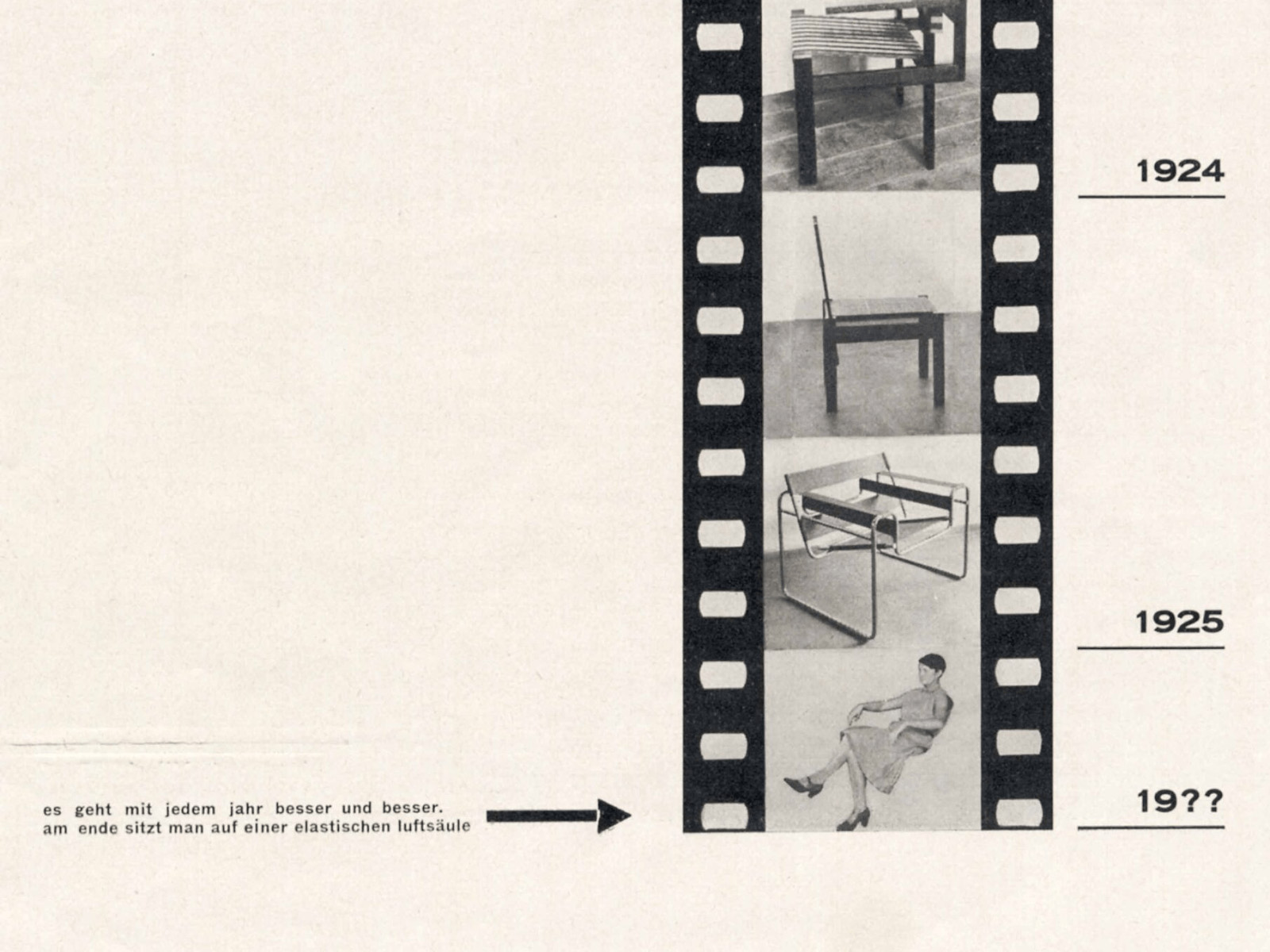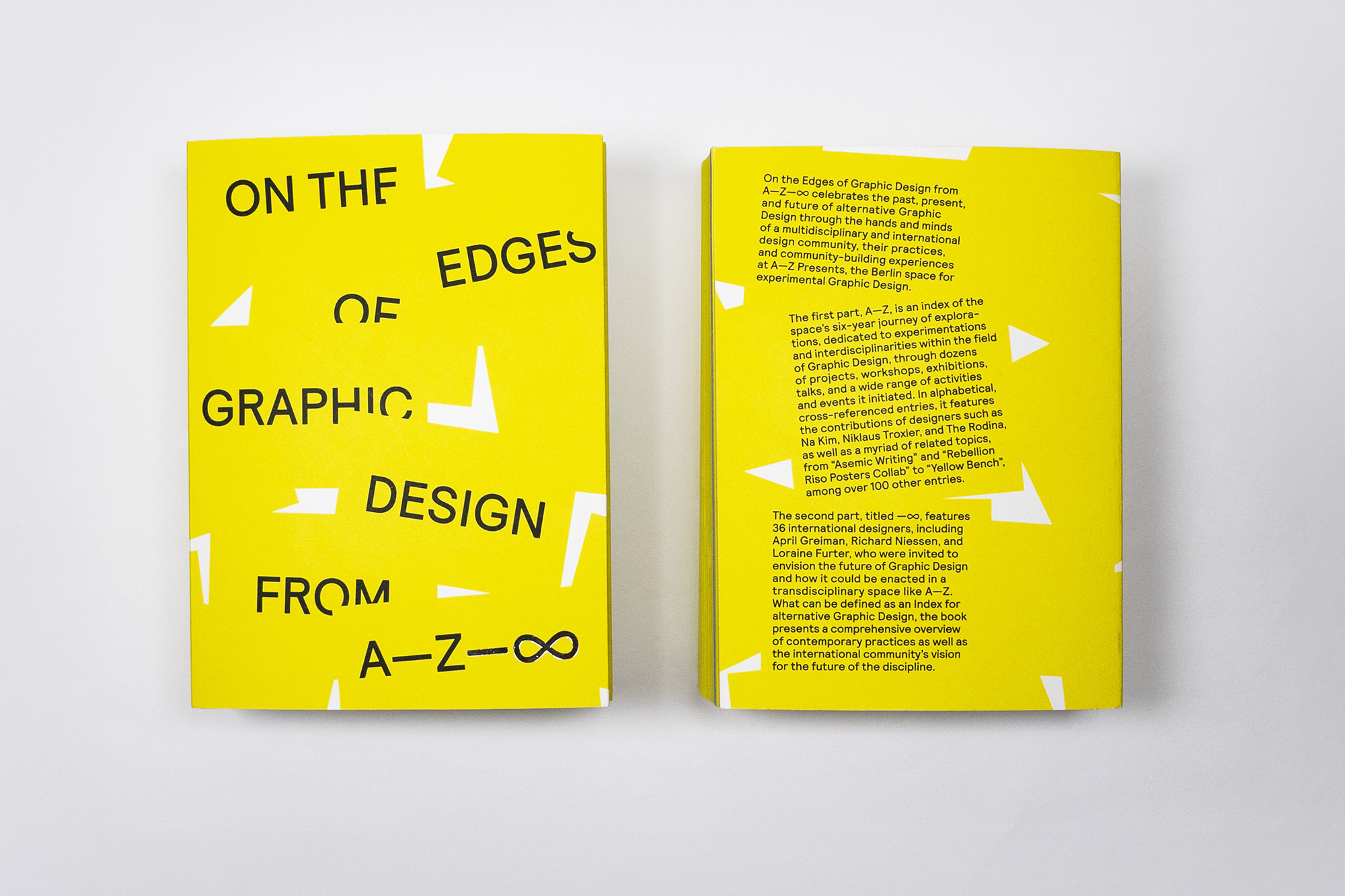If you’re sitting down, try to get in touch with the chair you’re sitting on. If you’re not, try to imagine a specific chair. Consider the characteristics that communicate what the chair is capable of doing. Can it support your arms? Is the back straight, tilted, or curved? Is it upholstered? Can it be folded? These elements of the chair’s design constrain the possibilities it can evoke: a chair with an inclined back may beckon the user toward relaxation, while a hard chair with a straight back may keep them at attention. In some way, with the designer no longer present, the chair is directly exercising an object-will on the sitter. As the person sitting in the chair struggles to stay awake or shifts uncomfortably against the chair’s form, a conversation is happening. Both the chair and its user express specific intentions, and their perspectives are not always aligned.

“es geht mit jedem jahr besser und besser. am ende sitzt man auf einer elastischen luftsäule”
Marcel Breuer – a modernist architect with a portfolio of opinionated chair designs – poked fun at this in a 1926 poster reading (roughly translated), “[chair design] gets better and better every year. In the end, one sits on an elastic air column.” The quote appears alongside an image of a woman hovering, reclined, in mid-air, placidly demonstrating that the objects that govern our lives could, at some future point, meet the contours of our deeply subjective experiences.

Le Corbusier’s Eyes That Do Not See celebrates raw functional design
A few years earlier, in his 1923 essay Eyes That Do Not See1, Swiss-French architect Le Corbusier famously asserted that, far from just an air column, “an armchair is a machine for sitting in.” This often-quoted line is an exemplar of Corbusier’s dedication to the “new spirit” of functionalism that would influence design over the following century. But by describing objects like ocean liners as an “important manifestation of temerity, discipline, and harmony, a beauty that is calm, vigorous, and strong,” Corbusier projects subjective qualities from the object he observes onto the people involved in its production. There’s a tacit admission here that no matter how functional and minimal the object becomes, we can still see, as if through a two-way mirror, qualities of the subjects who created it and subsequently see subjective qualities in the object itself. While functionalism celebrated mechanized production for its promises of efficiency, scale, and quality of life, these prospects were all owed to its ability to prune back the humanity of the objects it produced. Human inefficiency, a proclivity toward frivolity, and the slow pace of human hands could all be eliminated, optimizing objects toward their “pure” forms. In a way, machines were understood to be replacing humans as the producers of material culture. A culture that, because we fixate on aesthetic expression, our eyes, according to Corbusier, cannot see.
As an interface designer, I hear clear echoes of the past in today’s discussions and the products coming out of them. After all, technology is a particularly fertile ground for functionalist theory and practice. The systematization of the materials and objects we build with – from silicon, electricity, and code up to the glass rectangles encasing them – gives us ready models for systematizing the things we build. Our understanding of the discipline itself is also colored by this conflicted functional mindset: attempts to discuss what design “is” still carefully elide concepts like self-expression and the subjectivity of the designer. Art, we think, is the domain of subjective interaction and meaning; of self-expression; design must be something else. Since Corbusier’s time, this defensive framing has been crucial to advancing the practice and its economic viability. Physical mechanization tied economic value directly to design’s tangible outputs, placing demands for objectivity on the process itself. Whether something “works” in this context depends on whether the right subjective decisions were made leading up to the point of the object’s manifestation, a point at which the subjectivity of both designer and object is supposed to cease. These beliefs have continued into an era of digital production that should reconfigure the roles of design and designer both philosophically and in practice. The vocabulary of design’s intellectual mechanics in this era already includes inherently subjective and nuanced concepts like empathy and delight, revealing again that design is, at its core, a permanently subject-oriented discipline. We cannot escape our own humanity in order to create things for other humans. (Consider, for example, that the famous Eames war-time leg splint was modeled on Charles Eames’ own leg.)

As this tension continues to roil through the discipline, the sprouts of generative AI are emerging from their seeds at OpenAI, Google, Microsoft, Adobe, and others, and tools that replicate the embattled subjectivity at the heart of design have begun to spring up as its first leaves. Tools, for example, that place new screens into Figma files based on a statement of intent (a “prompt”), like all generative products, create what Karl Jaspers might call a mass-object2: a series of representations of an idea that lack exact origin or subjective meaning. The generated design, then, cannot be a good starting point even in a functionalist view: because we cannot know the subjective decisions that brought it to us, we cannot know if it actually “works.” We only know that it approximates something that could plausibly work, or looks like something that may have worked. Even editorial use of a generated screen is difficult since the edits necessary to make it a usable product lie at its foundation. To align designer and user intent in any meaningful way, the basic realities of the design must shift. Ironically, at the exact point in which we’ve removed humanity from the production of an object, it loses meaningful function, in a kind of overshoot of the functionalist purification of objects.
How, then, can we be expected to advance design with confidence toward and into an era of collaboration with machine learning models that – for now – can only generate simulacra of our actual creations?
To fully realize the potential of this coming era of design, we must reconsider the nature of the objects we create and imagine space for artificial intelligence not at the beginning or the end of the process of production but in the being of the object itself, evoking the subjectivity that’s always been present in the tangible outcomes of our work.
As interface designers, we must turn toward – not away from – the subjectivity inherent in our objects, recognizing that for as much as the techniques of design contribute to its viability as a part of business, the agency of the things we create contributes just as much or more. Philosopher Jane Bennett describes in Vibrant Matter how objects can act upon us3. Far from being a settled, prosaic declaration of human aspiration, in Bennett’s model, even Corbusier’s ocean liners would be poets able to express themselves and compel certain patterns of movement from their human counterparts. In Bennett’s view, objects – even those created by humans – act independently on us. A chair may compel us to put our feet up, shift our weight, and raise or lower our arms. Interfaces are the same; their manifestation, determined and formed by humans through careful practice, nonetheless evoke emergent behaviors, colloquial patterns of use, and new and unintended possibilities that give the interface-as-object its very own subjective viewpoint. This viewpoint, which Bennett calls “vitality” or “thing power”, is where we find the power of integrating AI into our work, making it dynamic enough to have a responsive “thing power” that works in harmony with users by understanding and sharing their perspective.
Peter-Paul Verbeek, a contemporary philosopher of technology, describes in What Things Do the ways in which technology’s co-constitutive relationship with humanity can open this possibility:
Human beings develop technology always from within a context which is coformed by technology: technology has helped to evoke and shape their needs and desires, likes and dislikes … Human beings are not sovereign with respect to technology, but are, rather, inextricably interwoven with it.4
Verbeek illustrates this with the telephone, a device that was initially invented to function as a hearing aid. “The context in which the device came to function,” Verbeek explains, “redefined it.” Subsequently, the telephone’s process of coming into existence allowed it to act on us by creating new possibilities that would reconfigure our relationship to communication.
This perpetual exchange of action between humans and technology – what we would call “user interaction” – unlocks new possibilities for both sides of the exchange. If, as designers, we are ready to admit that the subjectivities of the user, the interface, and ourselves are all present and active at the moment of use, we can begin to imagine how these three viewpoints can more meaningfully align. Designer, design, and user could operate – even from a distance – with a shared perspective on reality; the designer, in creating an abstract system capable of adapting in meaningful ways to expressions of user intent, consciously creates an object imbued with a more dynamic subjectivity, while the user expresses their intent simply by using the design as they usually would and observing how it aligns with their intended results. This reconfiguration is where the pattern-building power of generative AI could find its place.

The idea of this alignment, the phenomenon of beliefs, thoughts, or feelings shared between two or more minds, is called intersubjectivity. A design practice that is more cognizant of this – as opposed to productivity or the replacement of human creativity – shows the potential of what generative AI could hold for our work. A more intersubjective design practice would not just acknowledge but focus on the idea that the interface as an object acts upon users in a way that doesn’t fully belong to either designers or users. It would allow us to directly engage with the way an interface could begin to perceive and respond to the perspective of a user through inputs, choices, behaviors, and errors.
In some ways, the subjective decisions a designer makes leading up to the manifestation of an object contribute to a sort of meta-perspective, capturing the designer’s beliefs about the user’s perspective5. We might add a giant “Compose” button on the main screen of an email app because we learn ahead of time that composing an email is probably the most important action from a user’s perspective. This belief is then embodied in the app at the time of use, and – given the necessarily unique context of the user – the interface then acts upon the user from this perspective. If it’s mistaken, and the user has a different perspective on what makes an action the most important (or how big touch targets should be or how easily the user can learn new features, etc.), we can only change our design after receiving feedback, and only after we receive enough to confirm that a majority of users feel the same way. On the other hand, a system of interface that could synchronously recognize the user’s perspective and respond individually would be better prepared for shifting contexts and perspectives. The presentation of information, actions, components, and entire layouts could shift within their own design space. In other words, where generated screens as a starting point for design would lead to convergence on designs with unclear origins and intentions, machine intelligence implemented at the moment of use would allow the interface to grow and adapt organically by adjusting its own meta-perspective.
For now, using generative AI to create a living interface that can exist intersubjectively with users is still a vision. Generative AI lacks the crucial capacities of context, metacognition, and recursive thinking that humans use to form and communicate perspectives every day. But as technology progresses, designers can already begin to create more abstract systems, from simple visual signifiers to the concepts of components, layouts, screens, and apps we think about today. Each piece can be built with the capacity for true adaptation, individually and collectively, to prepare for a future where the interface comes into full bloom.
-
Le Corbusier, et al. “Eyes That Do Not See.” Toward an Architecture, Getty Research Institute, Los Angeles, CA, 2007. ↩
-
Jaspers, Karl (1955) Die geistige Situation der Zeit Berlin, Boston: De Gruyter. While Jaspers’ views on the relationship between humanity and technology were not without faults which are explored in Verbeek’s work, the idea of a mass object as the result of mass mechanized production (in this case, an analog for generative AI) is a useful one. ↩
-
Bennett, Jane, Vibrant Matter: A Political Ecology of Things. Duke University, 2010. ↩
-
Verbeek, Peter-Paul, and Robert P. Crease. What Things Do Philosophical Reflections on Technology, Agency, and Design. Pennsylvania State University Press, 2005. ↩
-
Gillespie, Alex and Cornish, Flora (2010) Intersubjectivity: towards a dialogical analysis Journal for the theory of social behaviour, 40 (1). pp. 19-46. ↩




